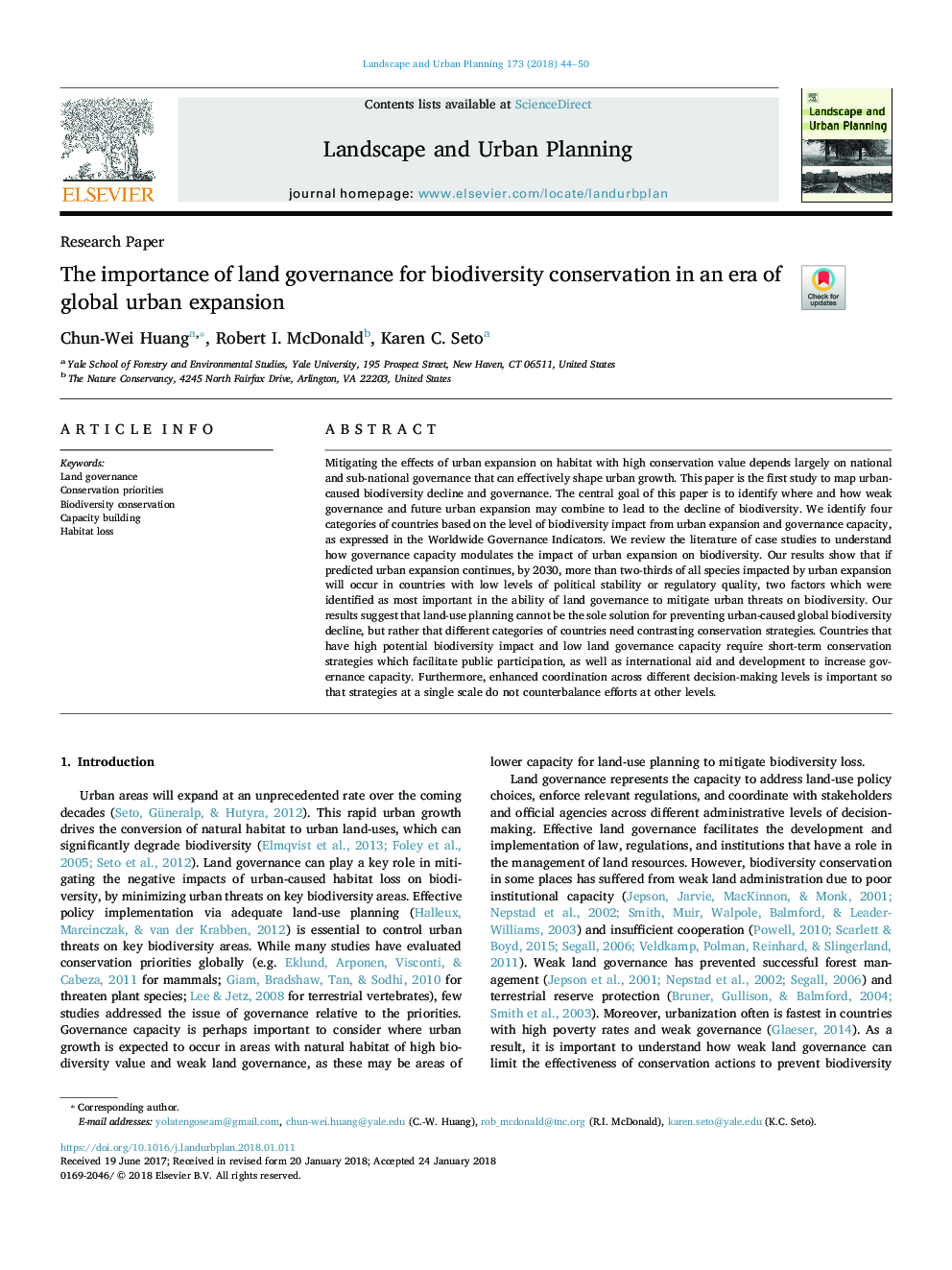| کد مقاله | کد نشریه | سال انتشار | مقاله انگلیسی | نسخه تمام متن |
|---|---|---|---|---|
| 7459838 | 1484585 | 2018 | 7 صفحه PDF | دانلود رایگان |
عنوان انگلیسی مقاله ISI
The importance of land governance for biodiversity conservation in an era of global urban expansion
ترجمه فارسی عنوان
اهمیت مدیریت زمین برای حفظ تنوع زیستی در عصر گسترش جهانی شهری
دانلود مقاله + سفارش ترجمه
دانلود مقاله ISI انگلیسی
رایگان برای ایرانیان
کلمات کلیدی
حکومت زمین، اولویت های حفاظت، حفاظت از تنوع زیستی، ظرفیت سازی، نابودی زیستگاه،
ترجمه چکیده
مقابله با اثرات گسترش شهری به زیستگاه با ارزش حفاظت بالا به شدت به حکومت ملی و فراملی بستگی دارد که می تواند رشد اقتصادی شهری را به طور موثر شکل دهد. این مقاله اولین مطالعهیی است که در مورد کاهش زیستی تنوع زیستی و حکومتداری ایجاد شده از سوی شهری صورت گرفته است. هدف اصلی این مقاله شناسایی کجا و چگونه حکومت ضعیف و گسترش شهرک آینده ممکن است ترکیب شوند تا منجر به کاهش تنوع زیستی شود. ما چهار دسته از کشورها را بر اساس سطح تأثیر تنوع زیستی از گسترش و ظرفیت حکومتداری مشخص می کنیم که در شاخص های حکومت جهانی در سطح جهانی بیان شده است. ما ادبیات مطالعات موردی را بررسی می کنیم تا بدانیم که چگونه ظرفیت اداری، تاثیر گسترش توسعه شهری را به تنوع زیستی می افزاید. نتایج ما نشان می دهد که اگر پیش بینی گسترش شهرها ادامه یابد، تا سال 2030، بیش از دو سوم از همه گونه هایی که تحت تأثیر توسعه شهری قرار دارند، در کشورهایی با سطح پایین ثبات سیاسی یا کیفیت نظارتی وجود دارد، دو عامل که مهمترین آنها در توانایی مدیریت زمین برای کاهش تهدیدات شهری به تنوع زیستی. نتایج ما حاکی از آن است که برنامه ریزی استفاده از زمین نمی تواند تنها راه جلوگیری از کاهش تنوع زیستی جهانی در جهان شهری باشد، بلکه این که گروه های مختلفی نیاز به استراتژی های حفاظت متفاوت دارند. کشورهایی که تاثیر بالقوه تنوع زیستی بالایی دارند و ظرفیت حاکمیت کم زمین، نیازمند استراتژی های حفاظت کوتاه مدت است که مشارکت عمومی، و نیز کمک های بین المللی و توسعه برای افزایش ظرفیت حکومتداری را تسهیل می کند. علاوه بر این، هماهنگی بهتر در سطوح مختلف تصمیم گیری مهم است، به طوری که استراتژی ها در مقیاس یکنواخت، تلاش های دیگر را در سطوح دیگر قرار نمی دهند.
موضوعات مرتبط
علوم زیستی و بیوفناوری
علوم کشاورزی و بیولوژیک
بوم شناسی، تکامل، رفتار و سامانه شناسی
چکیده انگلیسی
Mitigating the effects of urban expansion on habitat with high conservation value depends largely on national and sub-national governance that can effectively shape urban growth. This paper is the first study to map urban-caused biodiversity decline and governance. The central goal of this paper is to identify where and how weak governance and future urban expansion may combine to lead to the decline of biodiversity. We identify four categories of countries based on the level of biodiversity impact from urban expansion and governance capacity, as expressed in the Worldwide Governance Indicators. We review the literature of case studies to understand how governance capacity modulates the impact of urban expansion on biodiversity. Our results show that if predicted urban expansion continues, by 2030, more than two-thirds of all species impacted by urban expansion will occur in countries with low levels of political stability or regulatory quality, two factors which were identified as most important in the ability of land governance to mitigate urban threats on biodiversity. Our results suggest that land-use planning cannot be the sole solution for preventing urban-caused global biodiversity decline, but rather that different categories of countries need contrasting conservation strategies. Countries that have high potential biodiversity impact and low land governance capacity require short-term conservation strategies which facilitate public participation, as well as international aid and development to increase governance capacity. Furthermore, enhanced coordination across different decision-making levels is important so that strategies at a single scale do not counterbalance efforts at other levels.
ناشر
Database: Elsevier - ScienceDirect (ساینس دایرکت)
Journal: Landscape and Urban Planning - Volume 173, May 2018, Pages 44-50
Journal: Landscape and Urban Planning - Volume 173, May 2018, Pages 44-50
نویسندگان
Chun-Wei Huang, Robert I. McDonald, Karen C. Seto,
